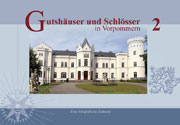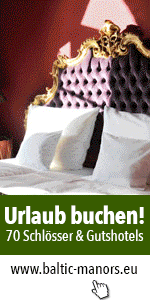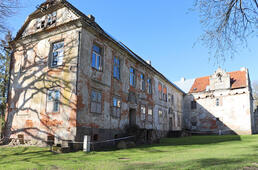Deutsche Website
Book "Manor houses and castles in Western Pomerania"

In Volume 2, we present 45 estates with short texts and more than 220 historical and current photographs on 155 pages.
Manor House (Castle, Moated Castle) Divitz
Not far from the small town called Boddenstadt Barth, in the Barthe valley, lies the moated castle called Divitz. It is one of the most important moated castles in the whole of northern Germany.
The castle, which is surrounded by an extensive moat, was discovered back in the early Middle Ages. The oldest part of the castle, the gable with the tower clock, was presumably built by a knight Conrad (or Cord) von Krakevitz. The castle was rebuilt in the 16th century. The two-storey north wing is from the second half of the 16th century. In the 18th century, the manor house was redesigned in Baroque style. Construction of the elongated east wing with two portals is documented to have taken place in 1729 and 1743. The two coats of shields above the doors, which are for the von Lilienstedt and von Krassow families, are also from around this time.
Before the 14th century, Divitz was the home of the knights of Divitz, who died out towards the end of the 14th century. In 1374, Divitz was owned by the von Vitzen family, the previous owners were the von Moltke family. From 1480 to 1625, it was the knights von Krackewitz who resided in Divitz. After the von Krackewitz family died out, the property was taken by the Duke. He rented it out to his chancellor, Philipp von Horn, from 1626 to 1690. The property was then delisted from the fief system and acquired by Johannes von Lilienstedt, who was later made an earl. He farmed on the property according to modern methods until 1735. The property was later passed on to the von Krassow family through inheritance. At the beginning of the 19th century, Prussian King Friedrich Wilhem IV. appointed Friedrich Heinrich von Krassow as an earl. Starting in 1844, his son Karl Reinhold Graf von Krassow took over the property. He too was particularly successful and was honored by King William I. through appointment to the “true secret council with the title of excellency”. Starting in 1842, the von Krassow family erected an entailed estate (inaleniable property that is always passed on through the family) with other properties: Frauendorf, Wobbelkow, and Martenshagen. After dissolution of the entailed estate, the property was acquired by the family of the Counts von Groeben for the period between 1892 and 1945. At the time, the property had a size of about 500 ha.
South of the estate is the landscaped garden, which was established between 1820 and 1830 by the Prussian court gardener, Gustav Meyer, on behalf of the von Krassow family.
After 1945, the manor house was used for residential purposes. Starting in 1990, the last occupants moved out.
The manor house was then sold by the municipality to an owner company during the early 1990s, but nothing was done on the building. On the contrary, heavy mortgages bore down on the castle, high costs were incurred by the Barth municipal office, and the estate was in a terrible condition in 2000: windows and doors were open, the stairs partially served as camp fires, the castle was at the verge of falling apart. Since reversing the purchase contract was not possible due to financial reasons, the property was offered for sale to a new prospective customer in 2001. In May 2001, the new owner moved in, hopeful and full of ideas. However, nothing has happened since then. On the contrary, the condition of the building has deteriorated further. In the end, it turned out not to have been a purchase, but only a leasing contract. The manor house is crumbling slowly, whereas the leaseholder is living in a nearby building.




